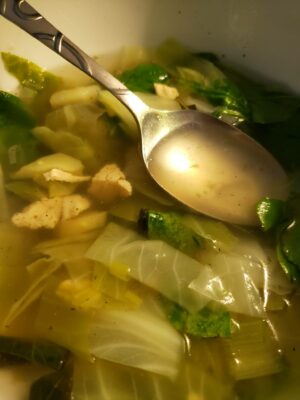
You have heard of the anti-inflammatory diet, or perhaps you have read articles about what foods in particular are good at reducing inflammation. Each list is different. Some lists include tomatoes, some lists don’t. My personal preference is to avoid nightshade vegetables (tomatoes, potatoes, eggplants, peppers) because they can be inflammatory for those of us with auto-immune disorders. There are so many lists of foods to eat and avoid that it can become overwhelming.
Tried and True
Sometimes with all the nutrition hype on the web we can bypass the tried and true remedies our grandmothers used. I grew up in the south so I knew that “pot liquor” was good for me. I didn’t know why, but I knew when turnip greens, mustard greens or collard greens were served up, asking for a cup full of the greens juice left in the pot was like getting a nutritional gold star on the calendar that day.
We know that raw vegetables are good for us too. Recent generations tend not to over-cook vegetables because they are not as nutrient-dense when cooked to mush, right? But boiling choice vegetables for the benefit of the broth is another story. We’ll get to that in a sec.
Autoimmune “Flare”
Most recently my own autoimmune disorder has decided to flare. That’s what we call it when our dis-ease acts out. I have Stage IV Pulmonary Sarcoidosis and for the most part I manage it holistically and have done well with that for the past 20 years, but now and again, Sarc apparently wants attention and she lets me know. My flares used to be primarily respiratory in nature but now flares cause systemic inflammation, and that is the case with many auto-immune disorders such as lupus, Multiple Sclerosis and Rheumatoid Arthritis.
I can tell you that a flare is no fun and no joke. I have done a darn good job finding optimal wellness for myself- being as healthy as I can be is always my goal. But the flares- they can take me to my knees and I find myself begging for grace and finding humility. Each time I experience a new flare, it is a soul dive into the next layer of wellness that includes my spirituality, my tribe, my doctors and new ways to love on food.
Cabbage is good and good for you!
This last go-round, I decided to re-visit an old friend. Cabbage. Cabbage doesn’t get as much attention these days with the likes of kale and other exotic leafy greens. But cabbage is a natural diuretic. You might not see it on a list of anti-inflammatory foods but if you look at lists for natural diuretic foods, there cabbage will be, along with celery, parsley, cucumbers, beets and garlic.
I remembered years ago, being told that cabbage was a natural diuretic. My doctor at the time (a country doctor working in the foothills of the Appalachians) told me to boil cabbage and drink the juice to reduce the swelling I was experiencing at the time due to lymphedema. I did, and it helped and then I forgot, because I got busy acquiring sarcoidosis so the country doctor’s wise words got lost in new pursuits of health and wellness.
On this flare I decided to revisit cabbage. Below I share my cabbage soup stock that you can make and modify. It makes an excellent base for just about any vegetable soup. Add your favorite soup ingredients and give your body the gift of detoxification.
DeeAnna’s Cabbage Soup Stock
In a large stock pot boil 1 medium cabbage head* cut into quarters with 3 or 4 stalks of celery (the heart of the celery if you can) and one medium onion, peeled and quartered. Vidalia is my FAVE! Peel and crush one clove of garlic (no need to chop) and throw that in for good measure.
 Add to the stock:
Add to the stock:
2 tsp each:
- Olive oil
- Dill
- Cumin
- Parsley (fresh is best)
- Himalayan salt or Sea salt (more to suit your taste)
- Pepper
Bring to boil then let simmer for 45 min- 1 hour.
*If you will use for soup immediately, you can chop the cabbage, celery and onion to bite size pieces, otherwise you can boil in larger pieces (quarter the cabbage, the onion and cut celery stalks into halves). If you are using this for soup stock, pour the liquid into small containers and freeze.
Creating your soup:
Use the soup stock as a base. You can add meat of your choice, beans such as white northern or pinto, and additional vegetables as you choose.
My favorite way to serve this broth is to place fresh organic raw beet tops or spinach into the soup bowl and pour the hot soup stock over the spinach. Add additional chopped green onions, fresh parsley and Asian basil on top.
When I make this for just the stock, I throw in an entire bunch of parsley along with the other ingredients- then I drain off the bulk vegetables and pour the stock into 2-cup containers to freeze. I drink at least a cup a day.
Post Script: If you are prone to kidney stones of the oxalate variety (not uncommon for people with Sarcoidosis, by the way) then reduce the celery and parsley in the broth and definitely skip the spinach and beet tops and be sure you consult with your doctor about a low oxalate diet.





